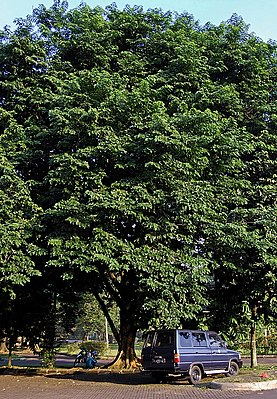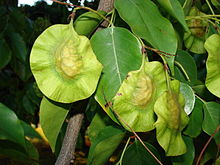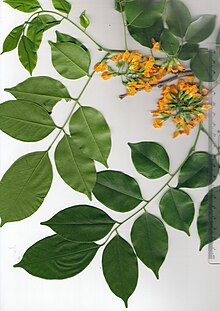Pterocarpus
| Pterocarpus | ||||||||||||
|---|---|---|---|---|---|---|---|---|---|---|---|---|

|
||||||||||||
| Systematics | ||||||||||||
|
||||||||||||
| Scientific name | ||||||||||||
| Pterocarpus | ||||||||||||
| Jacq. |
Pterocarpus is a genus of the sub-family of the Papilionaceae (Faboideae) in the family of the Leguminosae (Fabaceae).
Some Pterocarpus species are also called sandalwood trees or wing fruit trees, but both common names are also used for species of other genera: sandalwood trees for species from the sandalwood family (Santalaceae), wing fruit trees for species of the wing fruit family (Dipterocarpaceae). Wing fruit is a term for winged diaspores (units of distribution) that are transported by the wind, see meteorochory .
description
Appearance and leaves
The Pterocarpus species grow as evergreen to deciduous trees , rarely shrubs . Red juice leaks from the inner area when injured. Many of the species often form powerful buttress roots . Many species have a red cinema in their wood and bark . They are therefore also referred to as Bloodwood in English .
The imparipinnate leaves are up to 50 centimeters long. The leaflets are alternate to almost opposite on the rhachis . There are stipules present.
Inflorescences and flowers
Terminal or lateral, racemose or panicle inflorescences are formed. The bracts are just small.
The hermaphrodite flowers are zygomorphic and five-fold with a double flower envelope . The five sepals are fused together to form a bell-shaped calyx, with different calyx teeth of which the upper two are more or less fused. The flower crowns have the typical structure of the butterfly flowers . The five petals are yellow to orange in color. The flag is broadly ovoid to almost round. The shuttle is shorter than the two wings. The two petals of the shuttle are at most not overgrown. Nine of the ten stamens are fused together or the ten stamens are in two groups. The single carpel has only a few ovules . The scar is small.
Fruits and seeds
The lignified, circular legumes ( wing fruits ) consist of a central area of different thicknesses, usually containing only one, rarely up to three seeds, and a wide wing surrounding it; in some species the wing is a bit smaller. These legumes do not open on their own. The seed has a small hilum .




Occurrence
The genus , which comprises around 50 species, is pantropical , with over half occurring in Africa and Asia . Most species grow in the tropical rainforests; some species are also found in seasonal dry forests, swamps and savannas.
Systematics
The genus Pterocarpus was established by Nikolaus Joseph von Jacquin . The botanical genus name Pterocarpus means "winged fruit" and refers to the unusual shape of the legumes. A synonym for Pterocarpus Jacq. is Phellocarpus Benth.
The genus Pterocarpus belongs to the tribe Dalbergieae in the subfamily of the butterflies (Faboideae) within the family of the legumes (Fabaceae).
There are approximately 35 (25 to 50) species of Pterocarpus :
- Pterocarpus acapulcensis Rose
- Pterocarpus albopubescens Hauman
- Pterocarpus amazonum (Benth.) Amshoff
- East African Padouk ( Pterocarpus angolensis DC. )
- Pterocarpus antunesii (Taub.) Harms
- Pterocarpus brenanii Barbosa & Torre
- Pterocarpus claessensii De Wild.
- Pterocarpus dalbergioides DC.
- Pterocarpus echinatus Pers.
- African sandalwood ( Pterocarpus erinaceus Poir. ): It is found in the savannahs of the Sudan and Guinea zones in tropical Africa.
- Pterocarpus gilletii De Wild.
- Pterocarpus hockii De Wild.
- Pterocarpus homblei De Wild.
- Narrabaum ( Pterocarpus indicus Willd. ): It is mainly found in tropical Asia in Cambodia , Thailand , Myanmar , Malaysia , East Timor , Indonesia , the Philippines , the People's Republic of China and Japan as well as on the Pacific islands : Palau , Micronesia and Vanuatu .
- Pterocarpus lucens Lepr. ex Guill. & Perr.
- Pterocarpus macrocarpus short
- Pterocarpus marsupium Roxb.
- Pterocarpus mildbraedii Harms
- Pterocarpus mutondo De Wild.
- American or West Indian dragon tree, dragon's blood tree ( Pterocarpus officinalis Jacq. )
- Pterocarpus orbiculatus DC.
- Pterocarpus osun Craib
- Pterocarpus rohrii Vahl
- Pterocarpus rotundifolius (Sond.) Druce
- Pterocarpus santalinoides L'Hér. ex DC.
- Red sandalwood or red sandalwood tree, padouk, potash tree ( Pterocarpus santalinus L. f. )
- African padouk ( Pterocarpus soyauxii Taub. )
- Pterocarpus ternatus Rizzini
- Pterocarpus tessmannii Harms
- Pterocarpus tinctorius Welw.
- Pterocarpus velutinus De Wild.
- Pterocarpus villosus (Benth.) Benth.
- Pterocarpus violaceus bird
- Pterocarpus zehntneri Harms
- Pterocarpus zenkeri Harms
The following species are currently no longer assigned to this genus:
- Pterocarpus australis Endl. → Callerya australis (Endl.) Sheet
- Pterocarpus cultratus Vell. → Lonchocarpus cultratus (Vell.) AMGAzevedo & HCLima
- Pterocarpus falcatus Vell. → Poecilanthe falcata (Vell.) Heringer
- Pterocarpus frutescens Vell. → Dalbergia frutescens (Vell.) Britton
- Pterocarpus gummifera Bertero ex DC. → Ateleia gummifera (Bertero ex DC.) D.Dietr.
- Pterocarpus lunatus L. f. → Machaerium lunatum (L. f.) Ducke
- Pterocarpus niger Vell. → Dalbergia nigra (Vell.) Allemão ex Benth.
use
- Wood
Dragon blood tree ( Pterocarpus officinalis )
Some Pterocarpus species are economically important timber. Their wood is mainly used for making musical instruments, veneer and furniture. Examples are the Zitan or Manila Padouk , Narrabaum ( Pterocarpus indicus ) and Burma Padouk ( Pterocarpus macrocarpus ) from Southeast Asia ; the African species Muninga or African Padouk ( Pterocarpus angolensis ) and African Padouk or Coral Wood ( Pterocarpus soyauxii ).
The bark ingredients ( flavonoids ) of Malabarkino ( Pterocarpus marsupium ) from South India were previously of pharmaceutical importance. The dragon blood tree, palo de sangre ( Pterocarpus officinalis ), which is native to Central America, is another type of cinema, a dragon blood resin , which is of medicinal importance due to its hemostatic effect. So- called African cinema was also made from Pterocarpus angolensis and Pterocarpus erinaceus .
swell
- RK Brummitt, DK Harder, GP Lewis, JM Lock, RM Polhill, B. Verdcourt: Leguminosae. In: Flora Zambesiaca. Volume 3, Part 3, 2007: online.
- Franz von Bruchhausen, Hermann Hager, Wolfgang Blaschek, G. Heubl, G. Abel, Eberhard Teuscher: Hager's handbook of pharmaceutical practice . 5th edition. Springer, 1998, ISBN 3-540-61619-5 , pp. 412-423 ( Pterocarpus on pp. 412-423 in Google Book Search).
Individual evidence
- ↑ Data sheet at International Legume Database Information Service = ILDIS - LegumeWeb - World Database of Legumes , Version 10.38 from July 20, 2010.
- ^ Pterocarpus in the Germplasm Resources Information Network (GRIN), USDA , ARS , National Genetic Resources Program. National Germplasm Resources Laboratory, Beltsville, Maryland.
- ↑ M. Bergmann, H. Gnamm, W. Vogel: The tanning with vegetable tanning agents: Gerbmittel und Gerbverfahren. Volume 2, Springer, 1931, ISBN 978-3-7091-5982-8 , p. 84.
Web links
- Leaflet Padouk (1.92 MB), on gdholz.net, accessed on November 14, 2016.
- Mark Hyde, Bart Wursten: Entry in the Flora of Zimbabwe, 2009 . (engl.)
- Entry at ILDIS The LegumeWeb .





